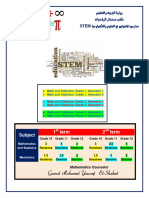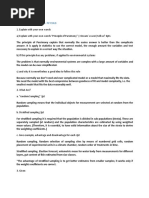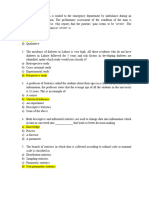0 ratings0% found this document useful (0 votes)
28 viewsS-Chapter 15: Frequency Distribution, Cross-Tabulation, and Hypothesis Testing
S-Chapter 15: Frequency Distribution, Cross-Tabulation, and Hypothesis Testing
Uploaded by
1517 Nahin IslamThis chapter discusses frequency distributions, cross-tabulation, and hypothesis testing. It covers creating frequency distributions and calculating common statistics like measures of central tendency and variation. The chapter also outlines the general procedure for hypothesis testing, including formulating hypotheses, selecting a statistical test, determining sample size, and making conclusions. Additionally, it discusses cross-tabulation with two or three variables and the associated statistics. The chapter concludes with discussing different types of hypothesis tests for differences, including parametric and non-parametric tests.
Copyright:
© All Rights Reserved
Available Formats
Download as PPTX, PDF, TXT or read online from Scribd
S-Chapter 15: Frequency Distribution, Cross-Tabulation, and Hypothesis Testing
S-Chapter 15: Frequency Distribution, Cross-Tabulation, and Hypothesis Testing
Uploaded by
1517 Nahin Islam0 ratings0% found this document useful (0 votes)
28 views4 pagesThis chapter discusses frequency distributions, cross-tabulation, and hypothesis testing. It covers creating frequency distributions and calculating common statistics like measures of central tendency and variation. The chapter also outlines the general procedure for hypothesis testing, including formulating hypotheses, selecting a statistical test, determining sample size, and making conclusions. Additionally, it discusses cross-tabulation with two or three variables and the associated statistics. The chapter concludes with discussing different types of hypothesis tests for differences, including parametric and non-parametric tests.
Original Description:
Hypothesis
Original Title
MR.S-CH15
Copyright
© © All Rights Reserved
Available Formats
PPTX, PDF, TXT or read online from Scribd
Share this document
Did you find this document useful?
Is this content inappropriate?
This chapter discusses frequency distributions, cross-tabulation, and hypothesis testing. It covers creating frequency distributions and calculating common statistics like measures of central tendency and variation. The chapter also outlines the general procedure for hypothesis testing, including formulating hypotheses, selecting a statistical test, determining sample size, and making conclusions. Additionally, it discusses cross-tabulation with two or three variables and the associated statistics. The chapter concludes with discussing different types of hypothesis tests for differences, including parametric and non-parametric tests.
Copyright:
© All Rights Reserved
Available Formats
Download as PPTX, PDF, TXT or read online from Scribd
Download as pptx, pdf, or txt
0 ratings0% found this document useful (0 votes)
28 views4 pagesS-Chapter 15: Frequency Distribution, Cross-Tabulation, and Hypothesis Testing
S-Chapter 15: Frequency Distribution, Cross-Tabulation, and Hypothesis Testing
Uploaded by
1517 Nahin IslamThis chapter discusses frequency distributions, cross-tabulation, and hypothesis testing. It covers creating frequency distributions and calculating common statistics like measures of central tendency and variation. The chapter also outlines the general procedure for hypothesis testing, including formulating hypotheses, selecting a statistical test, determining sample size, and making conclusions. Additionally, it discusses cross-tabulation with two or three variables and the associated statistics. The chapter concludes with discussing different types of hypothesis tests for differences, including parametric and non-parametric tests.
Copyright:
© All Rights Reserved
Available Formats
Download as PPTX, PDF, TXT or read online from Scribd
Download as pptx, pdf, or txt
You are on page 1of 4
S-CHAPTER 15
FREQUENCY DISTRIBUTION, CROSS-TABULATION, AND
HYPOTHESIS TESTING
Means of Quantitative Research (QR) begin from Chapter 15.
- However, the discussion of building blocks of QR started
long before (from Ch 6).
08/06/2022 Chapter 15 2
Synopsis: Chapter 15
• 1. Frequency Distribution
• - Distribution, Cumulative Frequency Distribution (p.449)
• - Histogram, F/polygon, Ogive (p.450)
• 2. Statistics Associated with FD (p. 451)
• (a) Measures of Location (Central Tendency):
• Mean, Median, Mode, Geometric Mean, Harmonic Mean,
• Quadratic Mean.
• (b) Measures of Variation:
• Mean Deviation, Standard Deviation, Coefficient of Variation
• (c) Measures of Shape:
• Skewness, Kurtosis and Moments
• 3. General Procedure for Hypothsis Testing (p.455)
• - There are 8 steps
3.GENERALPROCEDUREFORHYPOTHESISTESTINGContd. (p.433)
3
1. Formulate the null hypothesis, Ho and the alternative hypothesis, H1.
2. Select an appropriate statistical technique and the corresponding test statistic.
- Normal test, t-test, Chi square test, F-test , etc.
3. Choose the level of significance, (95%, 99%, etc.).
4. Determine the sample size (n) and collect data and calculate the value of the
test statistic.
5. Determine the probability associated with the test statistic under the Ho using
the sampling distribution of the test statistic.
OR
Determine the critical values associated with the test statistic that divide the
rejection regions.
6. Compare the probability associated with the test statistic with the level of
significance specified.
OR
Determine whether the test statistic has fallen into the rejection or non-rejection
region.
7. Make the statistical decision to reject or not reject the null hypotheses.
8. Express the statistical decision, conclusion, in terms of the research problem.
08/06/2022 Synopsis: Chapter 15 Contd. 4
• 4. Classification of Hypothesis Testing Procedure (a) Tests of Association
• (b) Tests of Difference
• 5. Cross Tabulation (CT) (p. 459): (a) 2 Variables (p.460)
• (b) 3 Variables (p.461)
• 6. Problems of 2-way CT Fig 15.7: (a) Refine an initial Relationship
• (b) Initial Relationship was Spurious
• (c) Reveal Suppressed Association
• (d) No Change in Initial Relationship
• 7. Statistics associated with CT (p. 464):
• (a) Chi square -statistic.
• (b) Phi Correlation Coefficient
• (c) Contingency Coefficient
• (d) Cramer’s V
• (e) Lambda Coefficient
• 8. Hypothesis Testing regarding Differences Fig 15.9(p. 469):
• (a) Parametric Tests: (i) One sample: t & z tests (p. 470)
• (ii) Two samples: Independents samples &
• Related samples.
• (b) Non-parametric Tests (P. 475)
You might also like
- MDRC A Practical Guide To Regression DiscontinuityDocument100 pagesMDRC A Practical Guide To Regression DiscontinuityMelike KöNo ratings yet
- Data Analytics (A) CS-503, B.Tech. 5 Semester Assignment QuestionsDocument2 pagesData Analytics (A) CS-503, B.Tech. 5 Semester Assignment QuestionsTele boy0% (1)
- Business Statistics 2023-25Document4 pagesBusiness Statistics 2023-25akshaymatey007No ratings yet
- 07 - Revised - Business Statistics 2022-24 - 10-10-2022Document5 pages07 - Revised - Business Statistics 2022-24 - 10-10-2022shubham chatterjeeNo ratings yet
- Biostatistics and Research MethodologyDocument5 pagesBiostatistics and Research Methodologydrashtirupavatiya1No ratings yet
- Statistics LODocument10 pagesStatistics LOkerolos fadyNo ratings yet
- Biostatistics MCQ'sDocument14 pagesBiostatistics MCQ'sannie naeem100% (1)
- Chapter Test: For B. V. Sc. & A. HDocument41 pagesChapter Test: For B. V. Sc. & A. HKNo ratings yet
- BP 801t Biostatistics and Research Methodology Jun 2020Document3 pagesBP 801t Biostatistics and Research Methodology Jun 2020Mr AggarwalNo ratings yet
- Statistics (Grade 3) LO 2022Document7 pagesStatistics (Grade 3) LO 2022Mohammed AltiabNo ratings yet
- EI 2022 Electronics and Instruments Engineering Etr 2022 PaperDocument47 pagesEI 2022 Electronics and Instruments Engineering Etr 2022 PaperRajath G RNo ratings yet
- Visvesvaraya Technological University, Belagavi: VTU-ETR Seat No.: ADocument48 pagesVisvesvaraya Technological University, Belagavi: VTU-ETR Seat No.: ASandhya GVNo ratings yet
- Statistics For ManagementDocument3 pagesStatistics For ManagementKMP TECHNOLOGYNo ratings yet
- - Hypothesis Testing Using the: Chi Square (χ) DistributionDocument35 pages- Hypothesis Testing Using the: Chi Square (χ) DistributionAbdii DhufeeraNo ratings yet
- 477 - STS 201Document16 pages477 - STS 201classikNo ratings yet
- Data Analysis Using MS Excel (Copy The Table Generated From MS Excel On Your Yellow Paper.)Document1 pageData Analysis Using MS Excel (Copy The Table Generated From MS Excel On Your Yellow Paper.)Januarie CasipitNo ratings yet
- Stat 111 - Tutorial Set 2Document7 pagesStat 111 - Tutorial Set 2Damien AfariNo ratings yet
- CV 22Document48 pagesCV 22ShivaKumarKNo ratings yet
- Polit & Beck Chapter 17 QUIZDocument6 pagesPolit & Beck Chapter 17 QUIZNicole LeeNo ratings yet
- CV Vtu Etr Question Paper 2020Document49 pagesCV Vtu Etr Question Paper 2020Rajani TogarsiNo ratings yet
- Visvesvaraya Technological University, Belagavi: VTU-ETR Seat No.: ADocument48 pagesVisvesvaraya Technological University, Belagavi: VTU-ETR Seat No.: AsravanNo ratings yet
- EC TE Version CDocument15 pagesEC TE Version CChandra Shekar MedarNo ratings yet
- Validation Model 2024-2Document37 pagesValidation Model 2024-2ozo1996No ratings yet
- Stats-Proj Group 2Document53 pagesStats-Proj Group 2princess theaa0% (1)
- Visvesvaraya Technological University, Belagavi: VTU-ETR Seat NoDocument48 pagesVisvesvaraya Technological University, Belagavi: VTU-ETR Seat NoRUDRESHA SNo ratings yet
- Stats ReviewerDocument5 pagesStats Reviewerlancecleotes09No ratings yet
- Visvesvaraya Technological University, Belagavi: VTU-ETR Seat NoDocument48 pagesVisvesvaraya Technological University, Belagavi: VTU-ETR Seat NoRUDRESHA SNo ratings yet
- Jarque-Bera Test: 1 HistoryDocument3 pagesJarque-Bera Test: 1 HistoryafjkjchhghgfbfNo ratings yet
- Vtu ETRDocument48 pagesVtu ETRRUDRESHA SNo ratings yet
- Visvesvaraya Technological University, BelagaviDocument17 pagesVisvesvaraya Technological University, BelagavimallikarjunbpatilNo ratings yet
- CRP505-151 Exam1 KeyDocument44 pagesCRP505-151 Exam1 Keywppzyv27tgNo ratings yet
- 954 Math T (PPU - STPM) Semester 3 Topics-SyllabusDocument5 pages954 Math T (PPU - STPM) Semester 3 Topics-SyllabusJosh, LRT67% (3)
- Chi SquareDocument34 pagesChi Squarenico huelmaNo ratings yet
- MC 2Document56 pagesMC 294qrhwdhdrNo ratings yet
- StatisticsDocument37 pagesStatisticsDishank UpadhyayNo ratings yet
- Visvesvaraya Technological University, BelagaviDocument17 pagesVisvesvaraya Technological University, BelagavimallikarjunbpatilNo ratings yet
- Civil Version CDocument13 pagesCivil Version CShivaKumarKNo ratings yet
- Indian Institute of Materials ManagementDocument5 pagesIndian Institute of Materials Managementjyotipansare16No ratings yet
- MAT121 StatDocument4 pagesMAT121 StattucchelNo ratings yet
- 7 Chi-Square and FDocument68 pages7 Chi-Square and FPuneet ChawlaNo ratings yet
- Statistics For Finance ASSIGNMENTDocument4 pagesStatistics For Finance ASSIGNMENTBethelhem MesfinNo ratings yet
- Visvesvaraya Technological University, Belagavi: VTU-ETR Seat No.: ADocument56 pagesVisvesvaraya Technological University, Belagavi: VTU-ETR Seat No.: ASneha NairNo ratings yet
- Chapter 11 - KT110HDocument15 pagesChapter 11 - KT110Hkhaai3108No ratings yet
- Harare Institute of TechnologyDocument5 pagesHarare Institute of Technologyntando ndlovuNo ratings yet
- Mtech 3 Sem Research Methodology mt302 2018Document2 pagesMtech 3 Sem Research Methodology mt302 2018Anshuman PatriNo ratings yet
- Data Analytics PDFDocument2 pagesData Analytics PDFTele boyNo ratings yet
- 100 Marks Test Statistics 26-06-2024Document16 pages100 Marks Test Statistics 26-06-2024Muhammad SufdarNo ratings yet
- Final 21Document9 pagesFinal 21ankun2122004No ratings yet
- EI 2023 Electronics and Instrument Engineering Etr 2023 PaperDocument56 pagesEI 2023 Electronics and Instrument Engineering Etr 2023 PaperRajath G RNo ratings yet
- Mtech 3 Sem All Research Methodology p3pgcc01 2020Document3 pagesMtech 3 Sem All Research Methodology p3pgcc01 2020utpalpatra1000No ratings yet
- Chapter F - Test: For B. V. Sc. & A. HDocument20 pagesChapter F - Test: For B. V. Sc. & A. HKNo ratings yet
- 5ccfcbc1e4b0a4eb53be4158 Original PDFDocument45 pages5ccfcbc1e4b0a4eb53be4158 Original PDFPoonam SachdevNo ratings yet
- Chi Square TestDocument17 pagesChi Square Testhvijay885No ratings yet
- StatisticsDocument30 pagesStatisticsAlex FernadezNo ratings yet
- SUMMATIVE TEST IN 3isDocument3 pagesSUMMATIVE TEST IN 3isAina kate BayucanNo ratings yet
- Anser Key 100 Marks TestDocument20 pagesAnser Key 100 Marks TestMuhammad SufdarNo ratings yet
- 3 CPA QUANTITATIVE TECHNIQUES Paper 3Document8 pages3 CPA QUANTITATIVE TECHNIQUES Paper 3Nanteza SharonNo ratings yet
- QCMDocument24 pagesQCMe4201No ratings yet
- Learn Statistics Fast: A Simplified Detailed Version for StudentsFrom EverandLearn Statistics Fast: A Simplified Detailed Version for StudentsNo ratings yet
- Ashley Goff EDU/HUS 325 Social Studies Activity Project "Community"Document14 pagesAshley Goff EDU/HUS 325 Social Studies Activity Project "Community"api-242664373No ratings yet
- Report of The Thirty Fifth Canadian Mathematical Olympiad 2003Document14 pagesReport of The Thirty Fifth Canadian Mathematical Olympiad 2003ProfefabianoNo ratings yet
- Lecture 1 Asymptotic NotationsDocument30 pagesLecture 1 Asymptotic NotationsQoryNo ratings yet
- ReSPR3001 PDFDocument2 pagesReSPR3001 PDFshyamchepurNo ratings yet
- A Guide To Tactical Appreciation 1987Document112 pagesA Guide To Tactical Appreciation 1987Andrea DiazNo ratings yet
- GRADE 9 Mod.10Document51 pagesGRADE 9 Mod.10Terrence RicafrancaNo ratings yet
- Documentatie MobilpayDocument12 pagesDocumentatie MobilpayMihai IsvoranuNo ratings yet
- AnyWeb - Trends 2024 - Which Technology Will Most Revolutionize Our FutureDocument16 pagesAnyWeb - Trends 2024 - Which Technology Will Most Revolutionize Our Futurebp6tjgxs4jNo ratings yet
- Designation D 2892 99a Standard Test MetDocument28 pagesDesignation D 2892 99a Standard Test MetBelén AndrangoNo ratings yet
- Lean Office PresentationDocument29 pagesLean Office PresentationSanjay MehrishiNo ratings yet
- Wipsy MenuDocument14 pagesWipsy MenuBergas WibowoNo ratings yet
- FINA201 Topic 3 CH 6 Slides Valuations and Bonds PrintingDocument8 pagesFINA201 Topic 3 CH 6 Slides Valuations and Bonds Printingayushmaharaj68No ratings yet
- Survey Design ChecklistDocument5 pagesSurvey Design ChecklistparameshNo ratings yet
- Writing E8 (Unit 7-12)Document17 pagesWriting E8 (Unit 7-12)Linh Nguyễn KhánhNo ratings yet
- Monetary PolicyDocument13 pagesMonetary PolicyAppan Kandala VasudevacharyNo ratings yet
- Appendices Performance ManagementDocument15 pagesAppendices Performance ManagementBrunoAndrade0% (2)
- Far Eastern University My Curriculum Institute of Arts and SciencesDocument3 pagesFar Eastern University My Curriculum Institute of Arts and SciencesUriel SarmientoNo ratings yet
- 801-Article Text-3269-1-10-20221226Document8 pages801-Article Text-3269-1-10-20221226liaaaNo ratings yet
- Exact Loss Formula ProofDocument7 pagesExact Loss Formula ProofYogita ChoudharyNo ratings yet
- Entanglements, or Transmedial Thinking About Capture by Rey ChowDocument20 pagesEntanglements, or Transmedial Thinking About Capture by Rey ChowDuke University PressNo ratings yet
- MN 7 038 2Document28 pagesMN 7 038 2Valrik IIINo ratings yet
- BHR PR LitDocument4 pagesBHR PR Litdonald duckNo ratings yet
- Generic PPT 5807 5808Document23 pagesGeneric PPT 5807 5808Angel BeronioNo ratings yet
- Rhetorical Analysis ArticleDocument6 pagesRhetorical Analysis Articleapi-242472728No ratings yet
- Technopreneurship 101: Value PropositionDocument27 pagesTechnopreneurship 101: Value PropositionAngel MendiolaNo ratings yet
- Ref7 PDFDocument7 pagesRef7 PDFJulian BermudezNo ratings yet
- Wstęp Do Językoznawstwa - NotatkiDocument14 pagesWstęp Do Językoznawstwa - NotatkijoannaaaaNo ratings yet
- PreviewDocument91 pagesPreviewStoie GabrielNo ratings yet
- (Your Business Name Here) - Safe Work Procedure Manual Metal Arc WelderDocument1 page(Your Business Name Here) - Safe Work Procedure Manual Metal Arc WelderSafety DeptNo ratings yet
- Space Mission Analysis: Dr. Andrew Ketsdever MAE 5595Document40 pagesSpace Mission Analysis: Dr. Andrew Ketsdever MAE 5595Mohd Fazri Sedan100% (1)

























































































